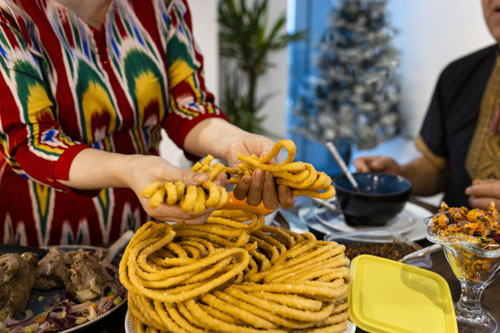A music store in the Grand Bazaar in Ürümqi, a city in the Xinjiang Uyghur Autonomous Region of China.
Written by Rebecca Schmor
Uyghur (pronounced “wee-gur”) is a Turkic language spoken in the Xinjiang Uyghur Autonomous Region in Western China. The language is also spoken in Uyghur communities across Kazakhstan, Kyrgyzstan, Pakistan, and Uzbekistan, totaling 20 million speakers according to the World Uyghur Congress. Uyghurs are predominantly Muslim, and the language uses a writing system derived from the Perso-Arabic script.
As a stateless nation, the Uyghurs have resisted assimilation efforts that threaten their linguistic, cultural, and religious practices and livelihoods. Meanwhile, Uyghur experiences and knowledge have been documented and preserved in books and poems, many of which have been translated into English and other languages. In this post, a Uyghur speaker talks about her language and culture. Because of the persistent repression of the Uyghur people, she has chosen to be identified using the name Emily.
How Emily Learned the Uyghur Language
Uyghur is Emily’s mother tongue, so she learned the language first from her parents and then at school. She remembers learning to read and write Uyghur at elementary school. For Emily, the learning process was like that of learning English: she studied the alphabet and then had to learn how to pronounce different words.
Emily’s Favourite Word in Uyghur
Emily’s favourite word in Uyghur is “ئويغان ” (oyghan), which means “wake up.” She likes this word because there is a 100-year-old Uyghur poem called “Wake up!” written by Abduhalik Uyghur. This poem can be listened to in Uyghur with English subtitles on YouTube.
Emily’s Favourite Parts of Uyghur Culture
As Emily explains, the history of the Uyghur people extends over more than two millennia and can be divided into four distinct phases dating back to 300 BC — Pre-Imperial (300 BC–AD 630), Imperial (AD 630–840), Idiqut (AD 840–1200), and Mongol (AD 1209–1600). So, the Uyghur people have an extremely rich history and culture. Emily’s favourite parts of Uyghur culture are its language, poetry, food, art, music, and dance. One of Emily’s favourite Uyghur books is called “ئۆزىنى ئىزدەش بوسۇغىسىدا ” (At the Edge of Finding Oneself), a 2005 collection of articles published by Abdukadir Jalalidin about his time studying in Japan. Emily also enjoys Uyghur folk music, like the love song Mitiz Meshrep.

Learn More About the Uyghur Language and Culture
To learn more about the Uyghur language and culture, Emily recommends checking out social media accounts like @DolanChick, which features an extensive collection of Uyghur cooking tutorials; @ÉliyarTursun, which includes short Uyghur language lessons; and @LaleDawut, which provides advanced Uyghur language lessons.
The Uyghurs: Audio Description Activity
Description
This activity invites learners to create audio descriptions (similar to closed captioning) for a video depicting Uyghur culture and traditions. This activity can be used with any target language and can be adapted to different language learning levels or goals. For example, depending on learners’ vocabulary knowledge, they could describe one of the video scenes by saying either “the women are making a rug” or “the women are spinning yarn.” Depending on the learning goals or curricular objectives, students could be encouraged to use the present progressive tense or focus on describing the people in the video. Depending on the class size and desired activity length, students could work on the entire 4-minute video or be divided into groups assigned 1 minute each.
Steps
- Watch the video “The Uyghurs” and take notes describing what the people in the video are doing.
- With your group members, use your notes to create a script (in the target language) to be used for audio description. Audio description allows people who are blind or have low vision to access visually recorded information (as closed captioning allows people with low or no hearing to access auditory information). Your description of the video should be detailed enough for someone to understand the video without being able to see what is happening.
- Translate your script into (an)other language(s) that you know. Pay attention to any similarities or differences between this script and the one in the target language.
- Record and submit your script(s) to your teacher for feedback. Make sure your recording matches the timing of the video.
- After you incorporate your teacher’s feedback, your teacher may choose to send your best recording(s) to the creator of the YouTube video, Stef Hoffer (stefhoffer@bossmgmtgrp.com), and recommend that he add them to the video as multilingual audio descriptions. In your class message, be sure to explain why it is important to provide access to this video in different formats and languages.
Commentary
By focusing on access to video description, this activity promotes awareness of the different ways in which people access language. It also enables crosslinguistic comparison of different languages in students’ repertoires, including heritage languages or other languages learned at school, by having students produce and compare translated content. The use of translation to mediate information has been recognized as a strategy for developing plurilingual competence and metalinguistic awareness (dela Cruz, 2023). Meanwhile, the activity engages students in the multimodality of language (Werner & Todeva, 2022) by having them create a written script and a voice recording. Finally, the activity offers an authentic and meaningful opportunity to contribute to the accessibility of a video on Uyghur culture, which can contribute to learner motivation during task completion (Pinner, 2019).
References
dela Cruz, J. W. N. (2023). Plurilingual strategies for teaching pronunciation in TESOL: A research-based and action-oriented approach. In Handbook of Multilingual TESOL in Practice (pp. 53–67). Springer Nature Singapore. https://doi.org/10.1007/978-981-19-9350-3_4
Pinner, R. (2019). Authenticity and teacher-student motivational synergy: A narrative of language teaching. Routledge.
Werner, R., & Todeva, E. (2022). Plurilingualism and multimodality: The metanoia within reach. TESL Canada Journal, 38(2), 214–227. https://doi.org/10.18806/tesl.v38i2.1362%20




